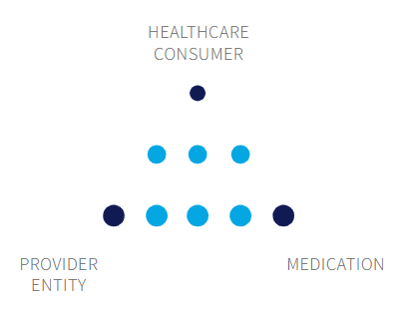Insights
Demystifying the Medication Use Process
A deeper look at Provider Entities
RevityRx’s medication use process (MUP) model illustrates the interdependent relationships between the stakeholders or nodes involved in the process. The nodes are Provider Entities, Healthcare Consumers, and the Medication. The model aims to simplify the complex MUP and establish a mutual understanding of the nodes at a high-level. For a greater appreciation of the process complexity, exploration into each node’s composition will identify MUP levers to transform a siloed collection of activities into a comprehensive medication stewardship framework. This Insight introduces RevityRx’s MUP maturity model, provides an overview of the provider segments within the node and deconstructs the elements that influence the MUP within each segment.

WHAT COMPRISES THE PROVIDER ENTITY?
The Provider Entity node encompasses the healthcare setting, systems, tools, and personnel having contact with the MUP. The segments of this node are integrated clinical networks, health systems, post-acute care facilities, community hospitals, federally qualified health centers and physician practice groups. Provider Entities are the primary drivers of medication use decision making however these decisions are influenced by a multitude of elements internal and external to the organization. Within each provider segment, assets consisting of systems, tools and personnel largely impact the MUP however system integration, patient relationship management, accreditation and operational elasticity are also contributors. Understanding each of these elements and their relationship to the MUP within each respective provider segment allows for greater insight into MUP opportunities.
MUP MATURITY MODEL
RevityRx’s MUP maturity model identifies organizations maturity stage as either developing, advancing or mature. Numerous factors may influence a Provider Entity’s drive to initiate medication use workflow and process improvements. These may involve medication related adverse events, quality ratings or changes within leadership, technology or human resources. At RevityRx, our goal is to partner with clients on MUP advancements, regardless of maturity stage, to achieve safe and high reliability care.
Developing
Clients in this category may or may not have formalized processes around medication use. Workflow and processes may be in place for select components of the medication use process. Care team or administration is aware that additional opportunities exist and/or better solutions are needed compared to current state. Entity stakeholders may lack awareness of MUP or have been unwilling to allocate resources to address opportunities in the past. It is important to note that in the developing stage, elements of the client’s current state MUP may or may not be well documented and the pros and cons identified.
Advancing
Clients in this category have formalized processes around medication use. Care team and administration has a clear understanding of the benefit of an integrated process however lack the knowledge or resources to move the program to the mature stage. The client has unresolved issues from the developing stage however most high priority items are remedied. Solutions to high priority items however may be in the form of a workaround due to other factors.
Mature
Clients in this category have formalized processes around medication use across sites of care. The client has addressed all high priority issues and most low priority issues with minimal workarounds. Administration openly values and supports the resources necessary for high reliability processes ensuring proper structures and governance are in place. Workflow and processes are fully aligned within care team with standardized communication methods and system integrations. Care team and administration are fully engaged in a performance improvement program, embracing learning and knowledge advancement.
Elements Influencing MUP
System Integration refers to an entity’s healthcare setting(s) and their ability to create systemness with the goal of high quality, high value and coordinated patient care.
| System Integration | |
| Integration | Details |
| Independent | Entity is an acute care hospital, stand-alone primary care or specialty provider service with or without an affiliation to other provider entities. |
| Horizontal | Entity has more than one acute care hospital or more than one physician practice group within the same type of provider service. |
| Vertical | Entity has one or more acute care hospitals in addition to primary care and specialty provider services. Entity may offer a range of other services under common control, providing care across the continuum. |
Patient Relationship Management is the period an entity impacts patient relationship within the MUP.
| Patient Relationship Management | |
| Period | Details |
| Episodic | Relationship isolated to specific site of care at defined point in time of patient receiving care, typically an intermittent acute care or ambulatory provider encounter. |
| Longitudinal | Relationship across the care continuum in multiple coordinated sites of care. |
Accreditation refers to an entity establishing the highest standard of health care quality.
| Accreditation | |
| Level | Details |
| Standard | Entity satisfies federal and state regulatory requirements typically to receive payment from federally funded programs. |
| Enhanced | Entity meets standard accreditation plus one or more specialty (e.g. professional practice or site of care) accreditations. |
| Advanced | Entity meets enhanced accreditation plus one or more center of excellence (COE) designated programs. |
Systems refers to an entity’s electronic medication record, structure, governance, revenue cycle management, programs and policies and their aptitude to deploy the MUP.
| Systems | |
| Degree | Details |
| Unknown | Entity has not evaluated systems alignment with the MUP. |
| Evolving | Entity has adequate structure and governance in place, recognizing additional need and has addressed some systems integrations. |
| Comprehensive | Entity has proper structure and governance in place and most systems are fully integrated with the MUP. |
Tools refers to an entity’s degree of alignment of systems through information technology solutions, workflows, protocols and guidelines within the MUP.
| Tools | |
| Degree | Details |
| Unknown/Low | Entity has not evaluated deployment of systems within the MUP or has siloed processes. |
| Moderate | Entity has optimized some tools and recognizes additional opportunities to break down MUP silos. |
| High | Entity has optimized most tools to reduce or eliminate waste and process variation, creating flow and care standardization within MUP. |
Personnel references the breadth of an entity’s human resources consisting of physicians, advance practice providers, clinical and administrative staff having direct or indirect contact with the MUP.
| Personnel | |
| Degree | Details |
| Limited | Entity’s human resources are pooled or provide cross discipline functions with fluctuating interdisciplinary team structure. |
| Concentrated | Entity has sufficient human resources to manage operations within a defined site of care and/or specialty area, may have limited interdisciplinary team structure. |
| Healthy | Entity has robust or ample human resources to manage operations with interdisciplinary team structure across sites of care. Depth and variety of skills sets, inclusive of learners, allows for innovation and advancement. |
Operational Elasticity rates an entity’s ability to adapt to the MUP based upon existing organizational environment.
| Operational Elasticity | |
| Rating | Details |
| Constraint | Entity has limited ability to modify operation. |
| Hybrid | Entity has flexibility to modify operation based on one or two of the following: patient volume, acuity, payer mix, care delivery model. |
| Dynamic | Entity has flexibility to modify operation based on three or more of the following: patient volume, acuity, payer mix, care delivery model. |
The RevityRx MUP maturity model serves as the foundation for Provider Entities on their journey to advance the MUP. Regardless of maturity, MUP opportunities will continually emerge across the care continuum. The maturity stage and the elements influencing medication use decision making within each respective Provider Entity allows for tailored improvements while considering the entity’s operational elasticity. This is achieved through clinical program optimization, organizational transformation, resource optimization and external partnership integration.
RevityRx partners with Provider Entities of all maturity stages to navigate the advancement of the MUP from fact finding, design, implementation, and sustainment of solutions. Further exploration into the composition of each node of RevityRx’s MUP model will help client’s identify levers to transform the MUP into a comprehensive Medication Stewardship Framework. Learn more at www.revityrx.com.

